

How a former policeman is using child's play to improve road safety - ABC News. A crash course on trauma-informed teaching. This week on the Truth for Teachers podcast, I’m giving you an overview of and a solid foundation for understanding trauma-informed teaching practices. Effective Questioning. Language in, language out. I was recently working with some School Leaders and I devised a basic model on the run with them about School Culture.

When I came home from this particularly engaging session I looked upon my new hastily conjured model, perhaps pondering just how clever I was to have spontaneously designed such a neat artifact, I realised that I may have gotten one small detail wrong – my audience. Here’s the model. I’d love to know what you think: To be up front, what I think I got wrong in terms of audience is that this model is probably far more important for Classroom Practitioners than it is for School Leaders.
Allow me to explain why. Language as an Input All of the literature around classroom climate/culture points to the importance of the language chosen by those with authority. Say the right things: Using effective classroom communication. A mixture of a large and influential audience, some trusted peers and the delivery of some new content meant I knew that I needed to prepare well.

And I did. I’d prepared a carefully constructed sequence in my head of the key points I would make, the stories that would accompany them and the neat segues I’d make to the next slide, speaking for just a moment to it before hitting the clicker and allowing the audience to see perfectly selected picture. The How and Why of Trauma-Informed Teaching. Working with trauma-affected students is a difficult balancing act. We acknowledge the harmful impacts of the past, and hold out hope for a future of healing. We create a safe environment for students to share their lives, yet maintain professional boundaries. Canberra education system set for 10-year overhaul in move to 'personalised learning'
Updated about 2 hours agoThu 16 Aug 2018, 12:24am Future school timetables may not have maths or English classes, but rather "critical thinking" and "creativity".
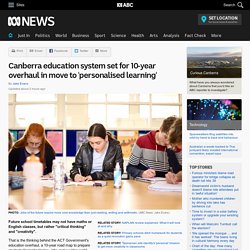
That is the thinking behind the ACT Government's education overhaul, a 10-year road map to prepare students for technologies, jobs and a wider world that does not yet exist. What will the Future of Education Strategy change? Children enrolled in learning from birthIncentives to increase staff diversityPersonalised learning programsSchools to become 'community hubs' for studentsNew digital assessment toolsEnhanced wellbeing and psychological supports In announcing the Future of Education strategy, acting school improvement director Kris Willis said it was "time for change" in education.
'Sensory-friendly' screenings held for cinemagoers with autism, other venues roll out quiet hours. Updated 56 minutes agoTue 24 Jul 2018, 1:57am Cinemas are turning the volume down and leaving the lights up during special 'sensory-friendly' film screenings designed for children with autism.
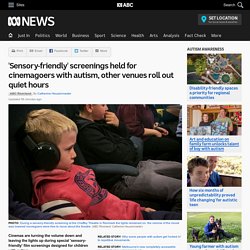
How Letting Students Teach Can Lead to Their Best Learning Ever. 5 tips to improve your critical thinking - Samantha Agoos. How a well-paid principal helped a struggling school lift academic performance. Posted Four years ago, the NSW Education Department undertook an experiment.
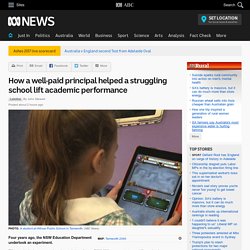
Examples of learning intentions. The learning intention is expressed in terms of knowledge, understanding and skills, and links directly with the relevant curriculum document.

The design of learning intentions starts with the answers to these questions. What do I want students to know? What do I want students to understand? What do I want students to be able to do? A certain challenge exists for teachers in translating the knowledge, understanding and skills of a published curriculum into learning intentions whose language is accessible to their students, but time spent on this preliminary step is in itself excellent professional learning. Some schools have made this 'unpacking' of the curriculum a focus of teacher meetings. Learning intentions that focus on knowledge Thinking about the different kinds of knowledge, and being specific about the kind of knowledge that is required in a particular situation, will help teachers design their learning intentions.They consider, for instance, Learning intentions that focus on skills.
Cooperative Learning in the classroom: How to do it. Competitive vs.
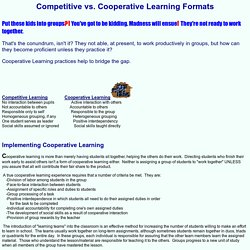
Cooperative Learning Formats Put these kids into groups?! The Seven Techniques of Learning to Learn. “Everything is easier than you think.
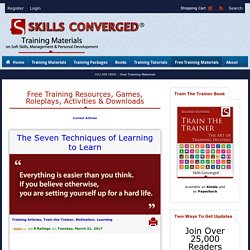
If you believe otherwise, you are setting yourself up for a hard life.” Visible Thinking. Purpose: What kind of thinking does this routine encourage?

This routine encourages students to make careful observations and thoughtful interpretations. It helps stimulate curiosity and sets the stage for inquiry. Understanding the Spectrum - a comic strip explanation. By Rebecca Burgess For version in Spanish click here..
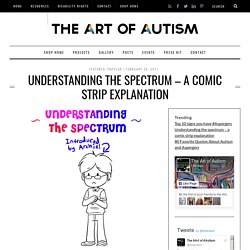
French version click here. For printable PDF version click here. Understanding the Spectrum - a comic strip explanation. Why Does Writing Make Us Smarter? Through our technology dependence, from smartphones to laptops, we seem to have a keyboard attached to our fingertips at all times. Have you thought about the last time you wrote something by hand? Research shows that our brains benefit from handwriting in multiple ways. Melissa Thompson talked with Dr. Marc Seifer, a graphologist, expert in handwriting, and the author of The Definitive Book of Handwriting Analysis (published in 2008). The Quest to Turn Challenging Student Behaviour Around. 4 Types of Accurate Rubric Descriptors. Working on improving your rubrics? Trying to keep them simple, yet provide accurate feedback? Rubric descriptors, which are the actual “meat and potatoes” of rubrics, need to be constantly tweaked to be easily understood.
This should ideally be done by both by the evaluator and the one being evaluated. The general rule of thumb as that descriptors should be specific, observable and measurable. The 10 Commandments of Teaching Difficult Students. Difficult students come in all shapes and sizes, ages, cultures, and demographics, you name it. The reasons for difficulties are as numerous as the stars.
However, they all share one thing: they’re hard to reach. Whether it be a learning disability, hardship, or trauma, they require extra effort and attention. But the master teacher can wade through all the outer displays of challenging behavior and pinpoint root causes. Predict My Future: The Science Of Us: The Early Years. The Most Important Things About Using Formative Assessment. Protocols and activities good for classroom use. The Best Ways of Using Essential Questions in the Classroom. Strategies to Build Intrinsic Motivation. SAS® Curriculum Pathways® Maths, Reading, Word Skills, Punctuation, Grammar. Studyladder, online english literacy & mathematics. Kids activity games, worksheets and lesson plans. Strategies for Behaviour disorders. 6 Tips For Creating Effective Student Groups. 6 Tips For Creating Effective Student Groups by TeachThought Staff Grouping students is easy; creating effective student groups is less so.
The Cold Hard Facts About Cyberbullying (Infographic)
Map skills and higher-order thinking - Map skills and higher-order thinking. Finding Students' Hidden Strengths and Passions. 7 Key Characteristics Of Better Learning Feedback. 7 Key Characteristics Of Better Learning Feedback by Grant Wiggins, Authentic Education On May 26, 2015, Grant Wiggins passed away. 20 Places to Educate Yourself Online for Free. 5 Keys to Inspiring Leadership, No Matter Your Style. Digital Is. The Role Of Empathy In Learning. Connected Education Might Not Mean What You Think - Finding Common Ground. The Complete Visual Guide To Technology For Children. How a Radical New Teaching Method Could Unleash a Generation of Geniuses. Howard Gardner: ‘Multiple intelligences’ are not ‘learning styles’